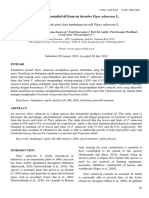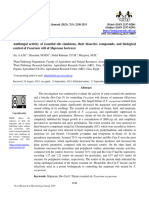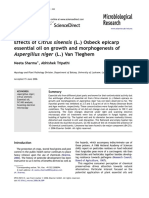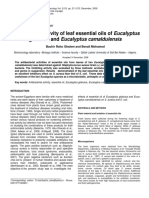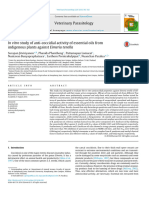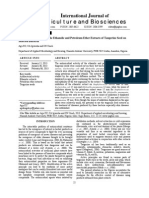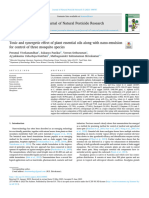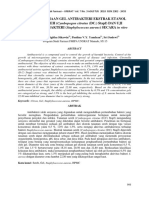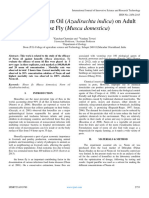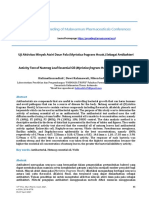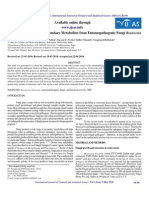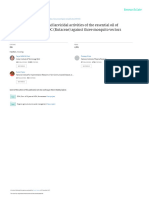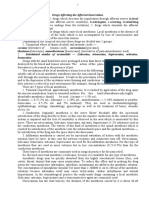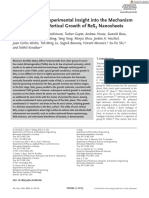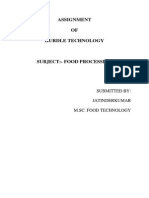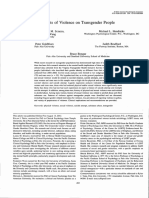Antibacterial Activity of Eucalpytus Citriodora Hk. Oil On Few Clinically Important Bacteria
Antibacterial Activity of Eucalpytus Citriodora Hk. Oil On Few Clinically Important Bacteria
Uploaded by
MuminovićCopyright:
Available Formats
Antibacterial Activity of Eucalpytus Citriodora Hk. Oil On Few Clinically Important Bacteria
Antibacterial Activity of Eucalpytus Citriodora Hk. Oil On Few Clinically Important Bacteria
Uploaded by
MuminovićOriginal Title
Copyright
Available Formats
Share this document
Did you find this document useful?
Is this content inappropriate?
Copyright:
Available Formats
Antibacterial Activity of Eucalpytus Citriodora Hk. Oil On Few Clinically Important Bacteria
Antibacterial Activity of Eucalpytus Citriodora Hk. Oil On Few Clinically Important Bacteria
Uploaded by
MuminovićCopyright:
Available Formats
See
discussions, stats, and author profiles for this publication at: https://www.researchgate.net/publication/27798072
Antibacterial activity of Eucalpytus citriodora Hk.
oil on few clinically important bacteria
ARTICLE in AFRICAN JOURNAL OF BIOTECHNOLOGY · JANUARY 2010
Impact Factor: 0.57 · Source: OAI
CITATIONS READS
10 24
3 AUTHORS, INCLUDING:
Yogeshkumar K. Vaghasiya
Saurashtra University
13 PUBLICATIONS 241 CITATIONS
SEE PROFILE
Available from: Yogeshkumar K. Vaghasiya
Retrieved on: 26 January 2016
African Journal of Biotechnology Vol. 7 (1), pp. 025-026, 4 January, 2008
Available online at http://www.academicjournals.org/AJB
ISSN 1684–5315 © 2008 Academic Journals
Short Communication
Antibacterial activity of Eucalpytus citriodora Hk. oil on
few clinically important bacteria
R. Nair, Y. Vaghasiya and S. Chanda*
Phytochemical Pharmacological and Microbiological Laboratory, Department of Biosciences, Saurashtra University,
Rajkot – 5, Gujarat, India.
Accepted 7 November, 2007
The antibacterial activity of Eucalyptus citriodora oil was evaluated. The volatile oil was extracted by
steam distillation method. The tested bacterial strains were Escherichia coli ATCC 25922,
Staphylococcus aureus, Proteus mirabilis NCIM2241, Pseudomonas aeruginosa ATCC27853, Proteus
vulgaris NCTC8313, Salmonella typhimurium, Enterobacter aerogenes ATCC13048, Pseudomonas
testosteroni NCIM 5098, Alcaligenes fecalis, Bacillus cereus ATCC11778 and Citrobacter freundii
ATCC10787. Piperacillin and Amikacin were used as the positive controls. The activity of the oil
increased with increase in concentration but decreased after a certain level. The study suggests that
isolation of the active compound from oil would give more satisfactory and promising results.
Keywords: Eucalyptus citriodora, Antibacterial activity, medicinal plant, volatile oil.
INTRODUCTION
Eucalyptus is a tall, evergreen tree, native to Australia MATERIAL AND METHODS
and Tasmania, successfully introduced worldwide, now
Plant material and extraction
extensively cultivated in many other countries including
India (Nadkarni, 1976; Grieve, 1979; Bruneton, 1995). The leaf material was collected in the month of September, 2003. It
The genus name Eucalyptus comes from the Greek word was identified by Dr. P. S. Nagar, Department of Biosciences, Saur-
eucalyptus, meaning “well-covered,” and refers to its ashtra University, Rajkot. The volatile oil was obtained by steam
flowers that, in bud, are covered with a cup-like mem- distillation and rectification from the fresh leaves (Indian Pharma-
copoeia, 1996). Different concentrations of oil were taken (10, 20,
brane (Grieve, 1979). Though native to Australia, its
30, 40, 50, 60 and 70 µl) and were dissolved in DMSO. The oil is
therapeutic uses have been introduced and integrated highly soluble in DMSO. This was used for the antibacterial assay.
into traditional medicine systems, including Chinese,
Indian Ayurvedic and Greco-European. It is focused
towards local use as an antiseptic. Topical application of Antibacterial activity
eucalyptus oil is effective against methicillin resistant S.
Antibacterial assay was done by agar well diffusion method (Perez
aureus infection (Sherry et al., 2001). Moreover, the anti- et al., 1990). Isolates of the following organisms: Escherichia coli
acterial action of oil of eucalyptus on local application is ATCC25922, Staphylococcus aureus, Proteus mirabilis NCIM2241,
also reported (Kumar, 1988; Ahmad and Beg, 2001). Pseudomonas aeruginosa ATCC27853, Proteus vulgaris
Eucalyptol (1,8-cineole) is the active ingredient of the NCTC8313, Salmonella typhimurium, Enterobacter aerogenes
eucalyptus oil (Bruneton, 1995). This paper reports on ATCC13048, Pseudomonas testosteroni NCIM5098, Alcaligenes
the antibacterial activity of eucalyptus oil. fecalis, Bacillus cereus ATCC11778 and Citrobacter freundii
ATCC10787 were obtained from National Chemical Laboratory
(NCL) Pune, India. They were maintained on N-agar slants at 4oC.
RESULTS AND DISCUSSION
*Corresponding author. E-mail: sumitrachanda@yahoo.com Since multidrug resistance of these microorganisms is a
024 Afr. J. Biotechnol.
Table 1. Antibacterial activity of Eucalyptus citriodora against few clinically important bacterial strains.
Zone of Inhibition (mm) produced by different concentrations
of oil dissolved in DMSO Antibiotic
Bacterial strain 10 µl 20 µl 30 µl 40 µl 50 µl 60 µl 70 µl DMSO Piperacillin Amikacin
E. coli 4 4 4 3 2.5 2.5 1.5 - 14 24
S. aureus 9 12.5 6.5 0.5 3.5 5 4 - 32 27
P. mirabils 3 6 12.5 18 14.5 5 4.5 - 0 23
P. aeruginosa 0 0 0 0 0 0 0 - 0 22
P. vulgaris 1.5 2 2 3 3 2.5 1 - 0 20
S. typhimurium 1 1.5 2.5 2.5 1.5 0.5 0.5 - 20 17
E.. aerogenes 5 6 5.5 5.5 1 0.5 0 - 22 20
P. testosteroni 2.5 3.5 4 3.5 1 1 1 - 0 30
A. fecalis 5 5 5.5 16 11 11 4 - 0 19
B. cereus 3 5 5 5 3 3 3 - 13 22
C. freundii 12.5 12.5 11.5 9.5 9.5 12.5 6 - 28 18
*Diameter of the disc is 7 mm (Himedia), DMSO was taken as control, and the results shown are the mean of three replicates.
Piperacillin – 100 µg/disc, Amikacin – 30 µg/disc.
major medical problem, screening of natural products in a in the oil could be useful in understanding the relations
search for new antimicrobial agents that would be active between traditional cures and current medicines.
against these organisms (Zgoda and Porter, 2001) is the
need of the hour. Here in the present study, antibacterial
activity of E. citriodora oil was checked against a battery REFERENCES
of clinically important bacterial strains. The oil was
Ahmad I, Beg AZ (2001). Antimicrobial and phytochemical studies on 45
generally active against all the bacterial strains studied Indian medicinal plants against multi-drug resistant human
except P. aeruginosa which was the most resistant pathogens. J. Ethnopharmacol. 74: 113-123.
bacterial strain studied. P. aeruginosa is problematic as it Beck WT, Cirtain MC, Glover CJ, Felsted RL, Safa AR (1988). Effects
of indole alkaloids on multidrug resistance and labeling of P-
has intrinsic resistance to several antibiotics and a glycoprotein by a photoaffinity analog of vinblastine. Biochem.
capability to acquire resistance during antibiotic therapy Biophys. Res. Comm. 153: 959-966.
(Beck et al., 1988). The pattern of antibacterial activity Bruneton J (1995). In: Pharmacognosy, Phytochemistry of Medicinal
varied with the increase in the concentration of oil and Plants. Paris: Lavoisier Publishing.
Grieve M (1979). A Modern Herbal. New York: Dover Publications, Inc.
decrease in the concentration of solvent. The oil showed
Indian Pharmacopoeia (1996). Delhi: Government of India, Ministry of
maximum activity at the concentration of 20 - 40 µl Health and Family Welfare—Controller of Publications, Vol. 1: 310.
against all the bacterial strains studied as shown in Table Kumar A (1988). Antibacterial properties of some Eucalyptus oils.
1. Amongst the gram negative strains studied, the oil was Fitoterapia 59: 141-144.
Nadkarni KM (1976). In: Indian Materia Medica. Bombay: Popular
highly active against P. mirabilis and A. fecalis. The oil
Prakashan.
was active against S. aureus amongst the gram positive Perez C, Paul M, Bazerque P (1990). Antibiotic assay by agar well
strains studied. DMSO was taken as the negative control. diffusion method. Acta. Biol. Med. Exp. 15: 113-115.
The activity of oil has been compared with standard Sherry E, Boeck H, Warnke PH (2001). Topical application of a new
formulation of eucalyptus oil phytochemical clears methicillin-resistant
antibiotics Piperacillin and Amikacin. From the present Staphylococcus aureus infection. Am. J. Infect. Control 29: 346-348.
study, it has been revealed that with the decrease in the Zgoda JR, Porter JR (2001). A convenient microdilution method for
concentration of DMSO, the activity of the oil decreased screening natural products against bacteria and fungi. Pharm. Biol.
which shows the role of solute and solvent interaction. 39: 211-225.
The study suggests that isolation of the active compound
from oil would give more satisfactory and promising
results. Isolation and identification of compounds present
You might also like
- Acog Practice Bulletin: Pregestational Diabetes MellitusDocument21 pagesAcog Practice Bulletin: Pregestational Diabetes MellitusGia DuyNo ratings yet
- MCkinsey Internal Guide - BiomassDocument23 pagesMCkinsey Internal Guide - BiomassfwfsdNo ratings yet
- Sulaiman Ali Al YousefDocument12 pagesSulaiman Ali Al YousefRifqi UlilNo ratings yet
- A Comparative Study of Effect of EssentiDocument5 pagesA Comparative Study of Effect of Essentidebby elizafitriNo ratings yet
- Effects of Oregano, Carvacrol and Thymol On Staphylococcus Aureus and Staphylococcus Epidermidis BiofilmsDocument5 pagesEffects of Oregano, Carvacrol and Thymol On Staphylococcus Aureus and Staphylococcus Epidermidis BiofilmsEllianaNo ratings yet
- 241 134745 1 10 20191230 PDFDocument9 pages241 134745 1 10 20191230 PDFIrenLayNo ratings yet
- Kordali 2008Document9 pagesKordali 2008khadijaNo ratings yet
- Potential Antibacterial Potential of Moringa Olifera against Multidrug Resistant Wound Infecting BacteriaDocument4 pagesPotential Antibacterial Potential of Moringa Olifera against Multidrug Resistant Wound Infecting BacteriaInternational Journal of Innovative Science and Research TechnologyNo ratings yet
- Bioactivity of Artemisia Herba Alba Essential Oil Against Plant Pathogenic FungiDocument7 pagesBioactivity of Artemisia Herba Alba Essential Oil Against Plant Pathogenic Fungisunaina agarwalNo ratings yet
- 10.28955-alinterizbd.445016-674440Document4 pages10.28955-alinterizbd.445016-674440abilashsundaresan04No ratings yet
- Evaluation of Antifungal Activity of Essential Oil From Chrysocoma Ciliate (Family-Asteraceae) LeavesDocument8 pagesEvaluation of Antifungal Activity of Essential Oil From Chrysocoma Ciliate (Family-Asteraceae) LeavesMr.S. p.royNo ratings yet
- In Vitro Investigation of The Antibacterial Activity of Nigella Sativa Oil On Some of The Most Commonly Isolated Bacteria in Otitis Media and ExternaDocument5 pagesIn Vitro Investigation of The Antibacterial Activity of Nigella Sativa Oil On Some of The Most Commonly Isolated Bacteria in Otitis Media and ExternaAnggie DiniayuningrumNo ratings yet
- Antimicrobial Effect of Plant Oils Against Some Bacterias Izolated From Patients SamplesDocument3 pagesAntimicrobial Effect of Plant Oils Against Some Bacterias Izolated From Patients Samplesbrislet RNo ratings yet
- mbl-48-2-148Document10 pagesmbl-48-2-148Handan BaysalNo ratings yet
- CHEMICAL COMPOSITION AND ANTIMICROBIAL PROPERTIES OF ALGERIAN CEDRUS ATLANTICADocument8 pagesCHEMICAL COMPOSITION AND ANTIMICROBIAL PROPERTIES OF ALGERIAN CEDRUS ATLANTICAReasmey TANNo ratings yet
- 2007.60-64 Sereh Sebagai AntibakteriDocument5 pages2007.60-64 Sereh Sebagai AntibakteriDeni oktaviaNo ratings yet
- Biological Activity of Essential Oil ofDocument3 pagesBiological Activity of Essential Oil ofdebby elizafitriNo ratings yet
- Poultrysci92-2834 The Effectiveness of Peppermint and Thyme Essential Oil Mist in ReducingDocument10 pagesPoultrysci92-2834 The Effectiveness of Peppermint and Thyme Essential Oil Mist in ReducingIsworo RukmiNo ratings yet
- Comparison of Antimicrobial Activities of Clove Oil & Its Extract On Some Food Borne MicrobesDocument7 pagesComparison of Antimicrobial Activities of Clove Oil & Its Extract On Some Food Borne MicrobesSeema YadavNo ratings yet
- Investigation of The Mutagenic and Antimutagenic Effects ofDocument11 pagesInvestigation of The Mutagenic and Antimutagenic Effects ofmyrtarom100% (2)
- Comparative Analysis of Anti-Bacterial Activity of Medicinal PlantsDocument4 pagesComparative Analysis of Anti-Bacterial Activity of Medicinal PlantsLeandro DouglasNo ratings yet
- Antifungal Activity of Essential Oils Emulsions, Their Bioactive Compounds, and Biological Control of Fusarium Wilt of Majorana HortensisDocument14 pagesAntifungal Activity of Essential Oils Emulsions, Their Bioactive Compounds, and Biological Control of Fusarium Wilt of Majorana Hortensisabdallah aliNo ratings yet
- Jurnal EucalyptusDocument15 pagesJurnal EucalyptusTesaaulia BaharuddinNo ratings yet
- Leaf_oil_compositions_and_bioactivities_of_Abaco_bush medicinesDocument10 pagesLeaf_oil_compositions_and_bioactivities_of_Abaco_bush medicinesaleNo ratings yet
- Ajol-File-Journals 674 Articles 259515 655b485fa0b81Document6 pagesAjol-File-Journals 674 Articles 259515 655b485fa0b81Blameless ArikoNo ratings yet
- Antimicrobial Activity of Essential Oil of Eucalyptus Globulus Against Fish Pathogenic BacteriaDocument4 pagesAntimicrobial Activity of Essential Oil of Eucalyptus Globulus Against Fish Pathogenic BacteriaLaires AraujoNo ratings yet
- 1 Malysian Journal FATIMA BOUAZZA 2022Document10 pages1 Malysian Journal FATIMA BOUAZZA 2022Fatima BouazzaNo ratings yet
- 1 s2.0 S0944501306000711 Main PDFDocument8 pages1 s2.0 S0944501306000711 Main PDFcenxontleNo ratings yet
- Article1380823069 - Ghalem and MohamedDocument5 pagesArticle1380823069 - Ghalem and MohamedVasiRebecaNo ratings yet
- Ji TV Iriya Non 2016Document7 pagesJi TV Iriya Non 2016Y TrầnNo ratings yet
- 19_915Document7 pages19_915tecnoco20No ratings yet
- Agriculture and Biosciences: Nternational Ournal ofDocument3 pagesAgriculture and Biosciences: Nternational Ournal ofGabriel TrujilloNo ratings yet
- Fu 2007Document6 pagesFu 2007RékaNo ratings yet
- In Vitro Tea Tree OilDocument6 pagesIn Vitro Tea Tree OilHilda FitriaNo ratings yet
- Fungitoxicity of The Essential Oil of Citrus Sinensis On Post-Harvest PathogensDocument7 pagesFungitoxicity of The Essential Oil of Citrus Sinensis On Post-Harvest PathogensSarthluz VanohNo ratings yet
- MEDHERB - Volume 8 - Issue 2 - Pages 71-78Document8 pagesMEDHERB - Volume 8 - Issue 2 - Pages 71-78Andreea RoxanaNo ratings yet
- Antimicrobial Profile Screening of Two Oils of Copaifera GenusDocument4 pagesAntimicrobial Profile Screening of Two Oils of Copaifera GenusandreaNo ratings yet
- Chemical Compsition and Antimicrobial Activity of Essential OilDocument5 pagesChemical Compsition and Antimicrobial Activity of Essential OilladilawalNo ratings yet
- Penting AromadendeDocument8 pagesPenting AromadendeAizhuuaf TurquoiseNo ratings yet
- Toxicity, Antimicrobial 2016Document6 pagesToxicity, Antimicrobial 2016Luz Clara Aguilar CorderoNo ratings yet
- Toxic and Synergetic Effect of Plant Essential Oils Along With Nano-EmulsionDocument10 pagesToxic and Synergetic Effect of Plant Essential Oils Along With Nano-EmulsionNgọc TrangNo ratings yet
- Antimicrobial Activity of Essential Oil Extract of Ocimum Basilicum L. Leaves On A Variety of PathogDocument4 pagesAntimicrobial Activity of Essential Oil Extract of Ocimum Basilicum L. Leaves On A Variety of PathogAna TorresNo ratings yet
- Antimicrobial Property of Over-the-Counter Essential Oils and Ayurvedic Powders Against Aeromonas Hydrophila Isolated From Labeo RohitoDocument4 pagesAntimicrobial Property of Over-the-Counter Essential Oils and Ayurvedic Powders Against Aeromonas Hydrophila Isolated From Labeo RohitoInternational Journal of Innovative Science and Research Technology100% (1)
- Evaluation of Antibacterial Effect of Extracted Fatty Acids of Nutmeg Myristica Fragrans (Houtt.) Against Locally Isolated BacteriaDocument7 pagesEvaluation of Antibacterial Effect of Extracted Fatty Acids of Nutmeg Myristica Fragrans (Houtt.) Against Locally Isolated BacteriaAndry LarsenNo ratings yet
- Uji AntibakteriDocument9 pagesUji AntibakteriserlinNo ratings yet
- Chemrj 2016 01 04 54 58Document5 pagesChemrj 2016 01 04 54 58editor chemrjNo ratings yet
- Efficacy of Neem Oil (Azadirachta Indica) On Adult House Fly (Musca Domestica)Document4 pagesEfficacy of Neem Oil (Azadirachta Indica) On Adult House Fly (Musca Domestica)International Journal of Innovative Science and Research TechnologyNo ratings yet
- Artikel 4 - Curcuma ZedoariaDocument10 pagesArtikel 4 - Curcuma Zedoariamonika puspitasariNo ratings yet
- Rosemary AntibacterialDocument5 pagesRosemary AntibacterialNurul Izzah Wahidul AzamNo ratings yet
- Chemical Composition of 8 Eucalyptus SpeDocument15 pagesChemical Composition of 8 Eucalyptus SpeAlex osorioNo ratings yet
- Antibacterial Activity of Turmeric Oil: A Byproduct From Curcumin ManufactureDocument4 pagesAntibacterial Activity of Turmeric Oil: A Byproduct From Curcumin ManufacturePGN20 DUCUSIN, Hugo Matteo T.No ratings yet
- WaelMohamedAbuEl WafaandWalaaSaidMohamedAbdEl AllDocument13 pagesWaelMohamedAbuEl WafaandWalaaSaidMohamedAbdEl AllCarl Ritchie TempleNo ratings yet
- Comparative in Vitro Study of The Antimicrobial Efficacy of Nigella Sativa Seed Oil (Black Seed Oil) Against Selected Microorganisms With Conventional AntibiticsDocument4 pagesComparative in Vitro Study of The Antimicrobial Efficacy of Nigella Sativa Seed Oil (Black Seed Oil) Against Selected Microorganisms With Conventional AntibiticsInternational Journal of Innovative Science and Research TechnologyNo ratings yet
- Clove AntibakteriDocument10 pagesClove Antibakterifiras saharaniNo ratings yet
- Phytochemical and Biological EvaluationDocument14 pagesPhytochemical and Biological Evaluationmasoudirad.1986035No ratings yet
- Admin, MPC13Document7 pagesAdmin, MPC13Aliyah SajaNo ratings yet
- 1343 Bbassiana MetabolitDocument3 pages1343 Bbassiana MetabolitRaúl Fernando Ruiz VillegasNo ratings yet
- Food Control: Wen-Rui Diao, Qing-Ping Hu, Hong Zhang, Jian-Guo XuDocument8 pagesFood Control: Wen-Rui Diao, Qing-Ping Hu, Hong Zhang, Jian-Guo Xumimi boukNo ratings yet
- In Vitro Evaluation of The Antibiogramic Activities of The Seeds of Myristica FragransDocument6 pagesIn Vitro Evaluation of The Antibiogramic Activities of The Seeds of Myristica FragransAndry LarsenNo ratings yet
- HelenDocument4 pagesHelenAhmad BukhariNo ratings yet
- Zantho 2Document8 pagesZantho 2Atrimed F & DNo ratings yet
- Modern Alkaloids: Structure, Isolation, Synthesis, and BiologyFrom EverandModern Alkaloids: Structure, Isolation, Synthesis, and BiologyErnesto FattorussoNo ratings yet
- 2 - HMTS PM1,2 Procedure HMTS-SES, 80, 80E, 142, 142D - Rev.2Document9 pages2 - HMTS PM1,2 Procedure HMTS-SES, 80, 80E, 142, 142D - Rev.2Fernando Lourenço100% (1)
- The Mechanically Extraction Process From Leaves and Twigs of Gambier (Uncaria Gambier Roxb) and Its Antioxidant ActivityDocument8 pagesThe Mechanically Extraction Process From Leaves and Twigs of Gambier (Uncaria Gambier Roxb) and Its Antioxidant Activity18O1125 ELIEN SUKMAWATINo ratings yet
- Medical Surgical Nursing Practice Test Part 1Document57 pagesMedical Surgical Nursing Practice Test Part 1Tina Van Winks100% (2)
- VOCABULARY Daily RoutineDocument3 pagesVOCABULARY Daily Routinecristylersam7No ratings yet
- Overhead DistributionDocument31 pagesOverhead DistributionZvandaziva NelisherNo ratings yet
- Gold Nanoparticles As Radiation Sensitizers in Cancer TherapyDocument11 pagesGold Nanoparticles As Radiation Sensitizers in Cancer TherapyErina NokomisNo ratings yet
- Anesthetics - They Decrease Afferent Nerves Sensibility B.astringent, C.covering, D.adsorbingDocument4 pagesAnesthetics - They Decrease Afferent Nerves Sensibility B.astringent, C.covering, D.adsorbingAnjaliNo ratings yet
- Dayliff Pump Controllers-3Document2 pagesDayliff Pump Controllers-3Charlie KebasoNo ratings yet
- Educ265-Maed279 - Maribojoc - Powerpoint 1 PresentationDocument37 pagesEduc265-Maed279 - Maribojoc - Powerpoint 1 PresentationHarold MaribojocNo ratings yet
- Encore Tricolore 4 Audio CD PackDocument15 pagesEncore Tricolore 4 Audio CD PackRabab AboubakrNo ratings yet
- Bacteriology Sample ExamDocument4 pagesBacteriology Sample ExamNathan James Guino-oNo ratings yet
- Guidelines For Quantitative Risk Assessment: Gevaarlijke StoffenDocument24 pagesGuidelines For Quantitative Risk Assessment: Gevaarlijke Stoffenbldp03No ratings yet
- Adv Funct Materials - 2018 - Ghoshal - Theoretical and Experimental Insight Into The Mechanism For Spontaneous VerticalDocument12 pagesAdv Funct Materials - 2018 - Ghoshal - Theoretical and Experimental Insight Into The Mechanism For Spontaneous Verticalmario.floresNo ratings yet
- Power Quality 1Document3 pagesPower Quality 1Miko QuijanoNo ratings yet
- English f1 Module (COMPILATION)Document20 pagesEnglish f1 Module (COMPILATION)AHDEARNo ratings yet
- ZKPQ 50 CCDocument8 pagesZKPQ 50 CCTanatologo y Psicoterapeuta David A. BenavidesNo ratings yet
- Bone HealingDocument18 pagesBone HealingHaziq Mars100% (2)
- Ti12a06s01 01en PDocument14 pagesTi12a06s01 01en PuchavezNo ratings yet
- So Maret 2021Document444 pagesSo Maret 2021Jimmy TanmadibrataNo ratings yet
- The 7 Skills To TRX BetterDocument26 pagesThe 7 Skills To TRX BetterFrederic GuerraNo ratings yet
- Assignment of Hurdle TechnologyDocument10 pagesAssignment of Hurdle TechnologyJatinder Kumar0% (1)
- HEMPCRETE (Material Report)Document11 pagesHEMPCRETE (Material Report)arpanatiwary19No ratings yet
- Cdi3 Prelim Midterm ReviewerDocument27 pagesCdi3 Prelim Midterm ReviewerCyrus B. Del Rosario100% (1)
- C 1+ 2 Surgicl Pathology of OesophagusDocument91 pagesC 1+ 2 Surgicl Pathology of OesophagusSayuridark5No ratings yet
- Doses and Mimosas Frat Culture Sexual Assault-4Document12 pagesDoses and Mimosas Frat Culture Sexual Assault-4api-608844347No ratings yet
- Effects of Violence On Transgender People: Rylan J. Testa, Laura M. Sciacca, and Florence Wang Michael L. HendricksDocument9 pagesEffects of Violence On Transgender People: Rylan J. Testa, Laura M. Sciacca, and Florence Wang Michael L. HendricksFlavia AliceNo ratings yet
- S.No Topic: Microgrid Nuclear BatteriesDocument3 pagesS.No Topic: Microgrid Nuclear BatteriesabhishekNo ratings yet
- Primary SyphilisDocument3 pagesPrimary SyphilisEqah TajuddinNo ratings yet





